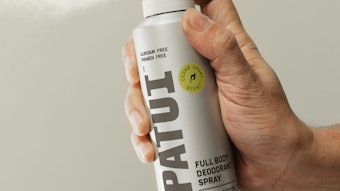
The AP/Deo market is evolving, shifting toward skin homeostasis solutions. This article proposes emerging approaches to manage body odor, including enzyme inhibition, pH and temperature modulation, and biotics for microbiome-friendly control.
This article is only available to registered users.
Log In to View the Full Article
The AP/Deo market is evolving, shifting toward skin homeostasis solutions. This article proposes emerging approaches to manage body odor, including enzyme inhibition, pH and temperature modulation, and biotics for microbiome-friendly control.
Body odor is caused by the bacterial metabolism of odorless sweat at different body sites – especially the underarm and armpit area. Such axillary body odor can be problematic, shaking self-confidence, and is undesirable, as evidenced by the market for deodorant, antiperspirant and other body odor-treating products. This large global market was valued in 2023 at around US $1.4 billion and is projected to reach $2.2 billion by 2033, expanding at a CAGR of 5.1% between 2024 and 2033.1
While essential for thermoregulation, sweat provides a nutrient-rich medium particularly for Staphylococcus spp., Corynebacterium spp. and Cutibacterium spp. As these commensal skin microbes metabolize sweat components to maintain skin homeostasis, they produce odor with the profiles of more than 120 compounds – of which thiols, acids and steroids are the major malodorants, with sweaty, spicy, urinous and musky organoleptic properties.2, 3
Staphylococcus also secretes sphingomyelinases, however, that provide ceramides to construct the epidermal permeability barrier.4, 5 And lipases secreted from Cutibacterium and Corynebacterium digest skin surface sebum and consequently produce free fatty acids6, 7 that maintain the acidity of skin.8 As such, killing these microbes to prevent malodor could disrupt skin homeostasis.
Traditionally, to prevent malodor, deodorants rely on broad-spectrum antimicrobials and other odor-masking agents while antiperspirants leverage aluminum salts (15-25% w/w) to physically obstruct sweat ducts; notably, the latter can cause folliculitis in some users and compensatory sweating. Both of these approaches, though, fail to address the biochemical basis of odor formation and compromise skin homeostasis.
Today, the antiperspirant and deodorant (AP/Deo) market is evolving rapidly, shifting toward consumer preferences for sustainability and skin homeostasis. Newer approaches to body odor management include enzyme inhibition, pH and temperature modulations, and microbiome-friendly microbe management – in many cases, featuring plant extracts and biotics, which fit perfectly with consumer demand.
The present article considers these emerging approaches. It reviews technologies to target enzymatic pathways and modulate the microenvironment, as well as biotic interventions to manage odor while also preserving microbiome balance and barrier function.
Biochemical Targeting of Odor-producing Microbial Enzymes
Body odor results from the bacterial biotransformation of non-odorous components secreted from sweat glands and sebaceous glands by means of enzymes including aminoacylases (N-acyl-amino acid amidohydrolases), C-S lyases (cysteine-S-conjugate β-lyases including arylsulfatase), β-glucuronidases and lipases.7, 8 Inhibiting these enzymes could therefore directly reduce malodor formation.
Several popular natural ingredients can inhibit these enzymes. Lemon balm, green tea (Camellia sinensis), mate (Hex paraguayensis), Japanese tea (C. japanensis), saw palmetto (Serenoa repens), Gingko biloba, yuzu, Phyllanthus emblica, Olea europaea, for example, demonstrate activities against arylsulfatase. Aminoacylase and cystathionine ß-lyase can be terminated by natural compounds with the homolog structure of O-acyl serine and threonine. Essential oils from Origanum, Thymbra, Satureja (high in carvacrol/thymol), Melaleuca alternifolia (tea tree oil) and others with terpinen-4-ol may also interfere with bacterial enzymes.3
Moreover, compounds that mimic the structure of body odor precursors (glutamine, Gln) can competitively bind with odor-causing enzymes; for example phenylethyl-D-galactoside, phenylethyl-D-glucoside and eugenyl-D-glucoside. These competitive substrates are digested with the bacterial-secreted enzymes, producing the fragrances phenylethanol and eugenol, respectively.
Chelators like ethylenediamine disuccinate (EDDS), ethylenediaminetetraacetic acid (EDTA), nitrilotriacetic acid (NTA) and O-phenanthroline – including the chelating agents of phosphates hexametaphosphate, sodium sulfate and sodium phosphate – and D-glucaro-Δ-lactone were reported on their antibacterial activities against lipases and aminoacylases as well as pentatic acid. The activity of arylsulfatase and β-glucuronidase also were reportedly suppressed by Cu2+ and chelating agents.3 In other words, polyvalent cations could prevent or reduce odor-causing enzymatic activities.
Microenvironment Modulation to Disfavor Odor-causing Bacteria
Modulating pH: Beyond targeting malodor-producing enzymes, modulating axillary skin pH to create an unfavorable environment for odor-producing bacteria is a promising strategy without disturbing the normal skin flora. A thin hydrolipid film on the skin surface maintains an average pH of 4.7 across most body sites, though the axilla tends to be slightly more alkaline (pH 5.5-6.5) due to higher sweat output.8 This acidity is primarily maintained by lactic acid from sweat, free fatty acids from sebum breakdown and natural moisturizing factors.9
Lowering the axillary pH to the acidic range can significantly inhibit microbial growth and metabolic activity without necessarily killing the microbes. Indeed, the activity of bacterial enzymes involved in odor formation, such as aminoacylases and C-S lyases, is pH-dependent, and may be reduced under acidic conditions. Furthermore, the activity of human skin enzymes involved in barrier repair and antimicrobial peptide processing is optimized at acidic pH;9 as stated, S. epidermidis contributes to barrier homeostasis by producing beneficial ceramides3 and it is more tolerant of acidic conditions.8 Maintaining an acidic pH thus selectively favors a microbiome profile less prone to generating strong odors.
Buffering the axillary environment toward its natural acidic state, counteracting the alkalizing effect of eccrine sweat (pH ~5-7) and apocrine sweat components, is therefore a promising strategy. Incorporating buffering agents with pKa values in the target range can help to maintain acidity even during sweat production. Common examples include citric acid/sodium citrate, lactic acid/sodium lactate and gluconic acid/gluconolactone. In addition, plant extracts rich in organic acids (e.g., fruit extracts) or polyphenols can contribute to an acidic pH, as well as ferments from Lactobacillus that produce lactic acid and other organic acids, lowering the pH and potentially offering prebiotic benefits.
Modulating temperature: In addition to axillary pH, temperature can be modulated to control sweat production. Sweat is the fundamental medium for bacterial growth and precursor delivery. Reducing sweat output, particularly in the axilla, directly decreases the substrate available for odor formation.
Thermoregulatory sweating is controlled by the sympathetic nervous system via acetylcholine signaling. Targeting TRP (Transient Receptor Potential) for localized skin surface cooling in the specific area where sweating is triggered is therefore an approach. TRP ion channels expressed on sensory nerve endings in the skin are key detectors of temperature changes.10 Specific TRP channels can be targeted to induce a sensation of cooling, which can trigger reflexes that reduce local blood flow and potentially modulate sweat gland activity. The TRPM8 channel, in particular, is activated by cold temperatures (below ~26-28°C) and cooling agents like menthol.11
Cooling products for body odor management are increasingly popular. However, menthol is the only regulatory-approved TRPM8 activator for topical products.10 One study showed that a gel with 4.6% menthol caused a significantly stronger cooling effect for 1 hr than 0.5% and 10.0% gels.12
Integrating Pre-, Pro- and Postbiotics
A cornerstone of the skin homeostasis approach is actively managing the axillary microbiome to favor a community less prone to generating malodor. Prebiotics, probiotics and postbiotics offer powerful tools for this purpose.
Prebiotics selectively nourish beneficial bacteria, creating a microenvironment hostile to odor-producing species. For example, alpha-glucan oligosaccharide promotes S. epidermidis growth, increasing lactic acid production and maintaining pH < 5.0.13
The introduction of probiotics may also support body odor suppression. Streptococcus salivarius K12, for example, has been shown to reduce volatile sulfur compounds14 although live probiotics face challenges in viability during formulation.
Postbiotics, i.e., inanimate microbial components, also offer advantages for body odor management. Lactobacillus ferment lysate contains bacteriocins and organic acids that inhibit lipases and aminoacylases.13 In addition, filtered Saccharomyces ferment provides short-chain fatty acids and enzymes that lower the pH and degrade odor precursors, consequently reducing malodor.15
Conclusion
Axillary body odor management is significantly evolving, driven by the scientific understanding of skin homeostasis, shifting consumer preferences toward health and sustainability, and stringent regulatory frameworks. Moving beyond broad-spectrum antimicrobials and physical sweat blockades, the future lies in strategies that respect and leverage the skin's natural biology.
Through strategies such as targeting the specific bacterial enzymes (e.g., aminoacylases, C-S lyases and lipases) responsible for odor formation; modulating axillary pH to favor beneficial commensals; regulating temperature to reduce sweat output physiologically; and actively harnessing the power of prebiotics, probiotics and postbiotics to shape a healthy, odor-resistant microbiome; effective odor control can be achieved without disrupting the delicate skin ecosystem.
Ingredients such as plant extracts, organic acids, chelators, buffering systems (citrate, lactate), cooling agents (menthol and possibly its synthetic analogs) and various biotic preparations are enabling the development of sophisticated, homeostasis-aligned products across diverse formats.
The global market, characterized by strong growth in natural/organic, aluminum-free and microbiome-friendly segments, provides a clear commercial imperative for this approach. However, navigating the complex regulatory landscape, particularly the safety requirements and claim substantiation rules for novel ingredients and microbiome claims, remains a critical challenge requiring expertise and robust scientific data.
But in the end, by working with the skin's natural biology rather than against it, these strategies promise not only effective odor control, but also the promotion of long-term skin barrier health and microbiome balance, marking a significant advancement in personal care that aligns scientific innovation with consumer demand and regulatory responsibility.
References
- Allied Market Research (2024, Sep). Deodorant and antiperspirant ingredients market. Available at https://www.alliedmarketresearch.com/deodorant-and-antiperspirant-ingredients-market-A15597.
- Natsch, A. and Emter, R. (2020). The specific biochemistry of human axilla odor formation viewed in an evolutionary context. Phil. Trans. R. Soc, (375) B37520190269; http://doi.org/10.1098/rstb.2019.0269
- Kanlayavattanakul, M. and Lourith, N. (2011). Body malodors and their topical treatment agents. Int J Cosmet Sci, (33) 298-311.
- Uchida, Y. and Park, K. (2021). Ceramides in skin health and disease: An update. Am J Clin Dermatol, (22) 853-866.
- Zheng, Y., Hunt, R.L., ... Otto, M., et al. (2022). Commensal Staphylococcus epidermidis contributes to skin barrier homeostasis by generating protective ceramides. Cell Host Microbe, (30) 301-313.
- Krutman, J. (2009). Pre- and probiotics for human skin. J Dermatol Sci, (54) 1-5.
- Swaney, M.H., Nelsen, A., Sandstrom, S. and Kalan, L.R. (2023). Sweat and sebum preferences of the human skin microbiota. Microbiol Spectr, (11) e0418022; http://doi.org/10.1128/spectrum.04180-22.
- Akaza, N., Takasaki, K., ... Yashiro, Y., et al. (2023). Relationship between skin fungal and bacterial microbiomes and skin pH. Int J Cosmet Sci, (45) 362-372.
- Schmid-Wendtner, M.-H., Korting, H.C. (2006). The pH of the skin surface and its impact on the barrier function. Skin Pharmacol Physicol, (19) 296-302.
- Zhang, M., Ma, Y., Ye, X., Zhang, N., Pan, L. and Wang, B. (2023). TRP (transient receptor potential) ion channel family: Structures, biological functions and therapeutic interventions for diseases. Signal Transduct Target Ther, (8) 261; https://doi.org/10.1038/s41392-023-01464-x.
- Craighead, D.H., McCartney, N.B., Tumlinson, J.H. and Alexander, L.M. (2017). Mechanisms and time course of menthol-induced cutaneous vasodilation. Microvasc Res, (110) 43-47.
- Lasanen, R., Julkunen, P., Airaksinen, P. and Töyräs, J. (2016). Menthol concentration in topical cold gel does not have significant effect on skin cooling. Skin Res Techno, (22) 40-45.
- Guéniche, A., Bastien, P., ... Castiel-Higounenc, I., et al. (2010). Bifidobacterium longum lysate, a new ingredient for reactive skin. Exp Dermatol, (19) e1-8; http://doi.org/10.1111/j.1600-0625.2009.00932.x
- Park, J.A., Lee, G.R., Lee, J.Y. and Jin, B.H. (2023). Oral probiotics, Streptococcus salivarius K12 and M18 suppress the release of volatile sulfur compounds and a virulent protease from oral bacteria: An in vitro study. Oral Health Prev Dent, (21) 259-270.
- Tsilingiri, K. and Rescigno, M. (2013). Postbiotics: What else? Benef Microbes, (4) 101-107.










